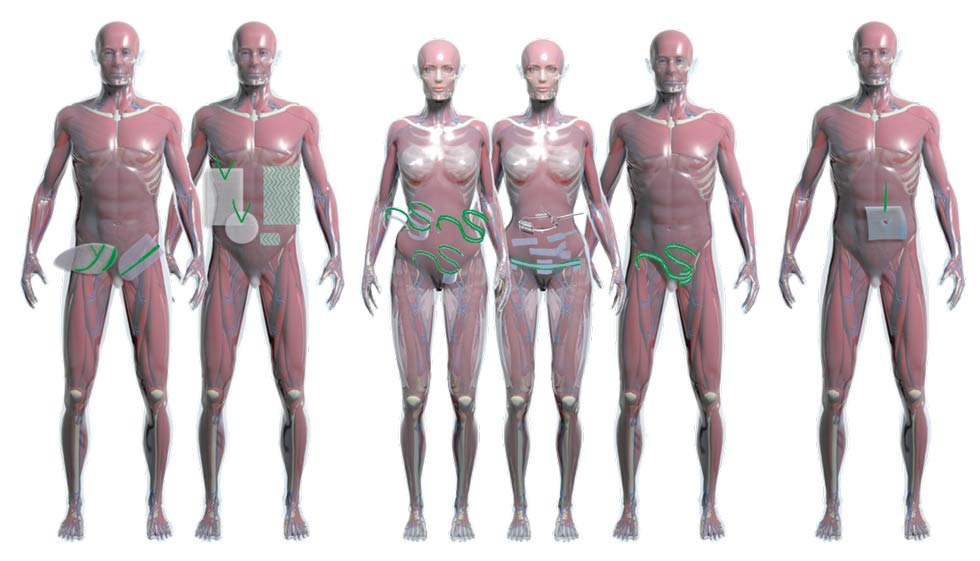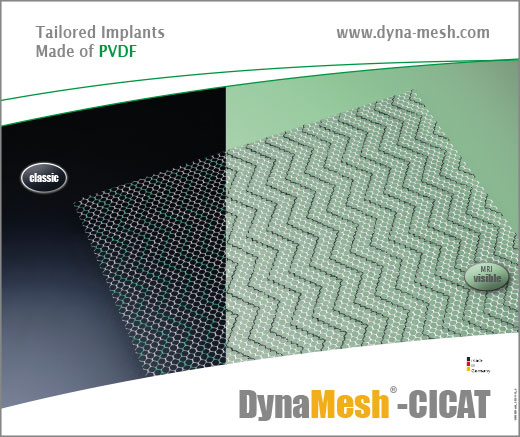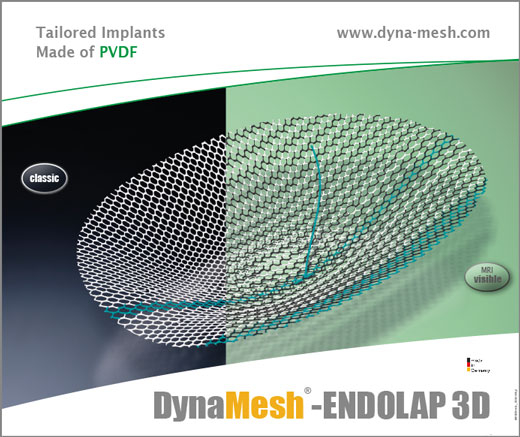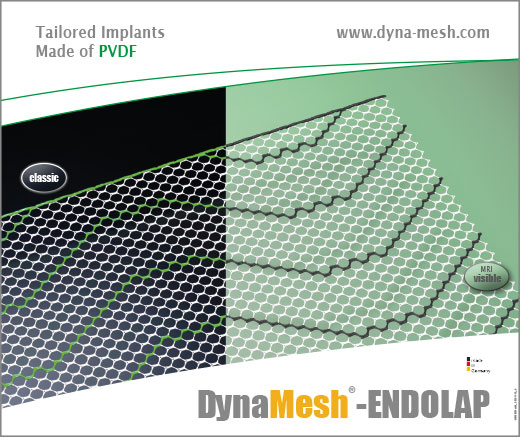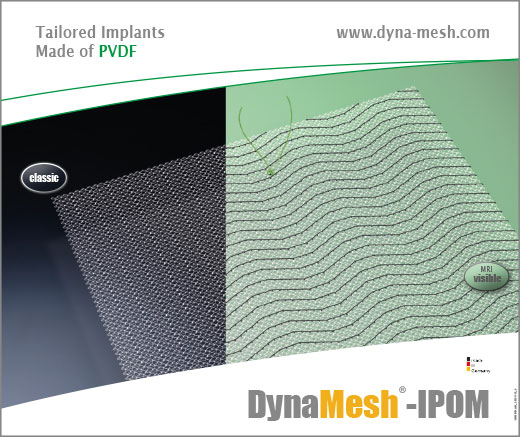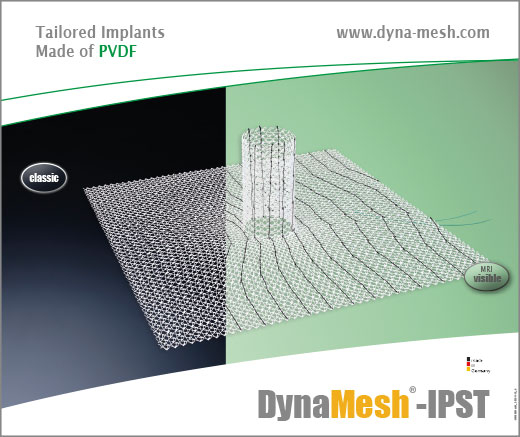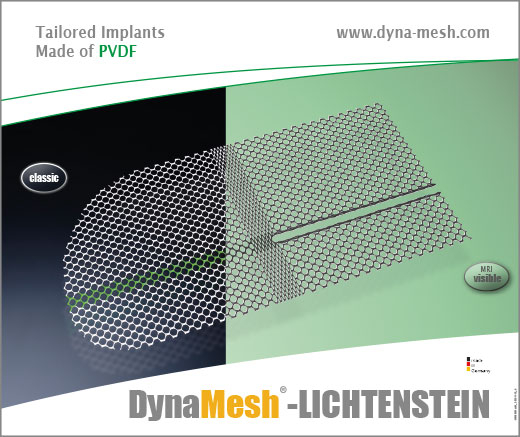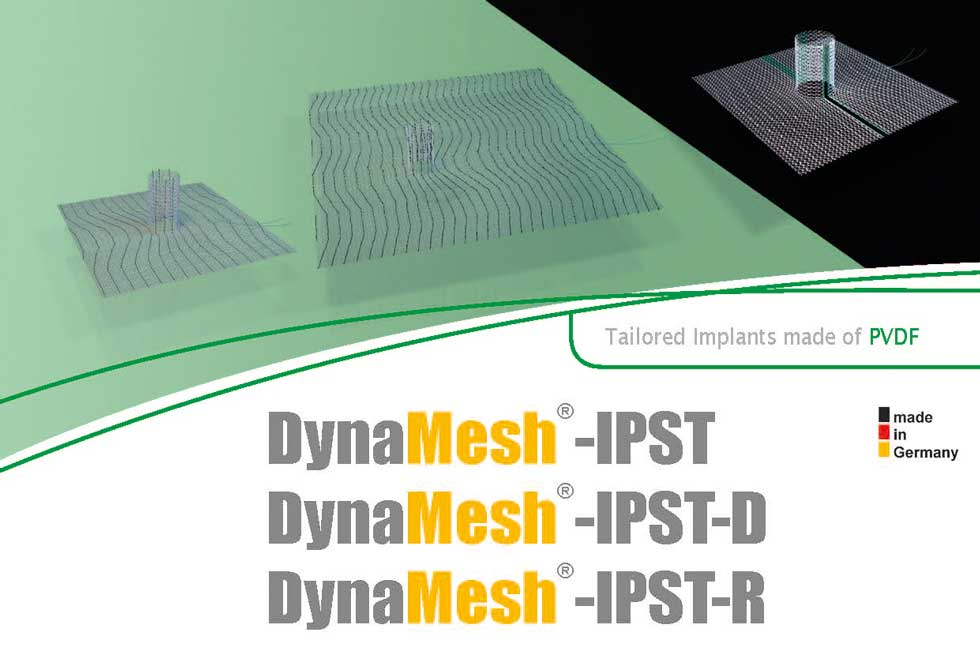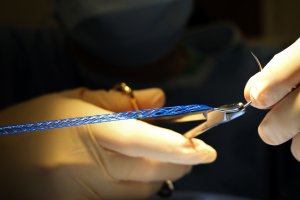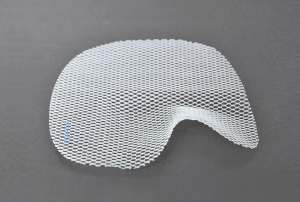DynaMesh
Het begint allemaal met een draad
In het begin, was er niet zo maar een draad, maar een filament van PVDF*: scheurvast, biocompatibel en glad. PVDF levert “van nature” veel van de eigenschappen die kenmerkend zijn voor een ideaal implantaat. De draad moet echter eerst kettinggebreid worden tot een textielstructuur. Niet zomaar, maar op maat gemaakt voor de betreffende indicatie. De juiste hechting maakt het verschil.
Alleen door de juiste hechting kunnen we de vereiste standaardmaatstaven behalen zoals: stabiliteit, elasticiteit en porositeit. Het eindresultaat is dus geen one-fits-all implantaat, maar een specifiek ontwikkeld DynaMesh® high-tech product.
*PVDF: Polyvinylideenfluoride, kan op verzoek zichtbaar worden gemaakt in MRI
Beschrijving
Productlijn
IPOM
- voor de intraperitoneale onlay mesh-techniek bij herniachirurgie
- optimale bediening in laparoscopische en open technieken
- en/of voor herstel van een navelbreuk met intraperitoneale mesh-positie
CICAT
- profylaxe voor reparatie van buikwandhernia met extraperitoneale mesh-positie en/of voor herstel van een navelbreuk met extraperitioneale mesh-positie
ENDOLAP 3D
Voor ENDOscopische (TEP) en LAParoscopische (TAPP) technieken voor herstel van lies- en femorale hernia’s
LICHTENSTEIN
voor het herstel van lieshernia’s met de Lichtensteintechniek
IPST
Voor het herstel en de preventie van parastomale hernia met intraperitoneale mesh-positie
DynaMesh® high-tech product
Omschrijving
DynaMesh producten, uitstekende eigenschappen
Uitstekende eigenschappen
- Hoge verouderingsbestendigheid
Het is niet alleen de ervaring die leert, dat PVDF blijvend succes biedt in veel chirurgische disciplines, Een lange-termijnonderzoek van 7 jaar heeft aangetoond, dat de toestand van het PVDF-oppervlak onveranderd blijft.
Draad- en ketting-gebreide stoffen blijven stabiel en worden niet broos.
- Minimaal reactief oppervlak
Wanneer u nadelige lichamelijke reacties en littekenvorming krijgt, welke gepaard gaan met textielimplantaten tot een minimum wilt beperken, moet u naast het gebruik van biocompatibel materiaal, ook zorgen voor een zo klein mogelijk contactoppervlak. De volgende formule is van toepassing: draadoppervlak = bioreactief oppervlak van het implantaat. Onze implantaten hebben een relatief minimaal reactief oppervlak, wat betekent dat ze zo min mogelijk lichamelijke reacties en littekenweefselvorming veroorzaken.
- Atraumatisch randen van de mesh
DynaMesh-producten worden niet zomaar uit een stuk gaas gesneden. Met behulp van onze speciale kettingbreimachines zijn wij in staat gladde en daardoor atraumatische zelfkanten te vervaardigen (geen “zaagtand” randen). Deze “zachte” randen maken het voor de chirurg gemakkelijker om het implantaat te plaatsen en aan te passen – zonder het omliggende weefsel te irriteren of zelfs te beschadigen. En de patiënt krijgt een implantaat met randen, die later niet zullen ‘knellen’ of ander letsel kunnen veroorzaken.
Superieure textieltechniek
- Optimale dynamometrie
Textielimplantaten moeten weefsel versterken, spieren ondersteunen en organen beschermen. Ze moeten verschillende krachten opvangen zonder de mobiliteit te beperken, inclusief de extreme spanningen die gepaard gaan met hoesten, niezen en lachen. Daarom is een optimale interactie tussen vooraf gedefinieerde stabiliteit en elasticiteit nodig. Wij bereiken de optimale balans tussen deze twee eigenschappen.
- Hoge weerstand tegen scheurverspreiding
Conventionele textielimplantaten hebben één zwak punt: eenmaal gescheurd of gesneden treedt er vaak een ritseffect op: het gaas blijft scheuren (meshbreuk). Bij DynaMesh-producten gebeurt dit niet. De meervoudige maastechniek die wordt gebruikt in onze kettinggebreide structuren laat dit ongewenste effect überhaupt niet toe. De weerstand tegen scheurverspreiding is één van de basiseigenschappen die al onze implantaten gemeen hebben.
- Effectieve porositeit
Tijdens de opname van de DynaMesh worden de filamenten omsloten door een intern en extern granuloom. Bij een te kleine filamentafstand bestaat het risico dat de gehele tussenruimte gevuld wordt met littekenweefsel (gesloten poriën). De littekenplaten die op deze manier ontstaan, veroorzaken veel ongemak bij de patiënt. Voldoende grote poriën kunnen dit voorkomen.


